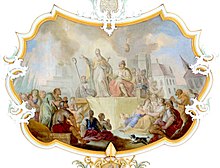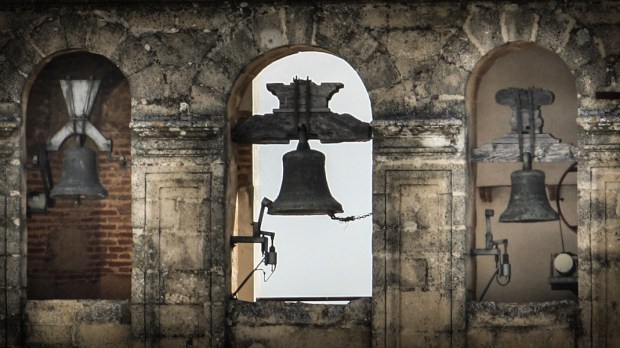TODAY IS THE FEAST DAY OF SAINT AIDAN OF LINDISFARNE

Aidan of Lindisfarne, born in Ireland, may have studied under St. Senan before becoming a monk at Iona. At the request of King Oswald of Northumbria, Aidan went to Lindisfarne as bishop and was known throughout the kingdom for his knowledge of the Bible, his learning, his eloquent preaching, his holiness, his distaste for pomp, his kindness to the poor, and the miracles attributed to him. He founded a monastery at Lindisfarne that became known as the English Iona and was a center of learning and missionary activity for all of northern England. He died in 651 at the royal castle at Bamburgh.
Aidan of Lindisfarne[a] (Irish: Naomh Aodhán; died 31 August 651) was an Irish monk and missionary credited with converting the Anglo-Saxons to Christianity in Northumbria. He founded a monastic cathedral on the island of Lindisfarne, known as Lindisfarne Priory, served as its first bishop, and travelled ceaselessly throughout the countryside, spreading the gospel to both the Anglo-Saxon nobility and the socially disenfranchised (including children and slaves).
He is known as the Apostle of Northumbria and is recognised as a saint by the Catholic Church, the Eastern Orthodox Church, the Anglican Communion, and others.
Biography
Bede's meticulous and detailed account of Aidan's life provides the basis for most biographical sketches (both classical and modern). Bede says virtually nothing of the monk's early life, save that he was a monk at the ancient monastery on the island of Iona from a relatively young age and that he was of Irish descent.[1][2] According to Catholic tradition, in Aidan's early years, he was a disciple of Saint Senan on Inis Cathaigh.[3] Aidan was known for his strict asceticism.[4]
Background
Aidan (died 651) was the founder and first bishop of the Lindisfarne island monastery in England. He is credited with restoring Christianity to Northumbria. Aidan is the Anglicised form of the original Old Irish Aedán, Modern Irish Aodhán (meaning 'little fiery one'). Possibly born in Connacht, Aidan was originally a monk at the monastery on the Island of Iona, founded by St Columba.[5]
In the years prior to Aidan's mission, Christianity throughout Britain was being largely displaced by Anglo-Saxon paganism. In the monastery of Iona (founded by Columba of the Irish Church), the religion soon found one of its principal exponents in Oswald of Northumbria, a noble youth who had been raised there as a king in exile since 616. Baptized as a Christian, the young king vowed to bring Christianity back to his people—an opportunity that presented itself in 634, when he gained the crown of Northumbria.[6]
Owing to his historical connection to Iona's monastic community, King Oswald requested that missionaries be sent from that monastery instead of the Roman-sponsored monasteries of Southern England.[4] At first, they sent him a bishop named Cormán, but he alienated many people by his harshness, and returned in failure to Iona reporting that the Northumbrians were too stubborn to be converted. Aidan criticized Cormán's methods and was soon sent as his replacement.[7] He became bishop in 635.[8]
Missionary efforts

Allying himself with the pious king, Aidan chose the island of Lindisfarne, which was close to the royal castle at Bamburgh, as the seat of his diocese.[4] An inspired missionary, Aidan would walk from one village to another, politely conversing with the people he saw and slowly interesting them in Christianity: in this, he followed the early apostolic model of conversion, by offering "them first the milk of gentle doctrine, to bring them by degrees, while nourishing them with the Divine Word, to the true understanding and practice of the more advanced precepts."[9] By patiently talking to the people on their own level (and by taking an active interest in their lives and communities), Aidan and his monks slowly restored Christianity to the Northumbrian countryside. King Oswald, who after his years of exile had a perfect command of Irish, often had to translate for Aidan and his monks, who did not speak English at first.

In his years of evangelism, Aidan was responsible for the construction of churches, monasteries and schools throughout Northumbria. At the same time, he earned a tremendous reputation for his pious charity and dedication to the less fortunate—such as his tendency to provide room, board and education to orphans, and his use of contributions to pay for the freedom of slaves:
The monastery he founded grew and helped found churches and other religious institutions throughout the area. It also served as centre of learning and a storehouse of scholarly knowledge, training many of Aidan's young charges for a career in the priesthood. Though Aidan was a member of the Irish branch of Christianity, his character and energy in missionary work won him the respect of Pope Honorius I and Felix of Dunwich.[10]
When Oswald died in 642, Aidan received continued support from King Oswine of Deira and the two became close friends.[11][12] As such, the monk's ministry continued relatively unchanged until the rise of pagan hostilities in 651.
During the time that he was bishop, the hostile army of the Mercians, under the command of Penda, cruelly ravaged the country of the Northumbrians far and near, even to the royal city, which has its name from Bebba, formerly its queen. Not being able to take it by storm or by siege, he endeavoured to burn it down; and having pulled down all the villages in the neighbourhood of the city, he brought thither an immense quantity of beams, rafters, partitions, wattles and thatch, wherewith he encompassed the place to a great height on the land side, and when he found the wind favourable, he set fire to it and attempted to burn the town. At that time, the most reverend Bishop Aidan was dwelling in the Isle of Fame, which is about two miles from the city; for thither he was wont often to retire to pray in solitude and silence; and, indeed, this lonely dwelling of his is to this day shown in that island. When he saw the flames of fire and the smoke carried by the wind rising above the city walls, he is said to have lifted up his eyes and hands to heaven, and cried with tears, "Behold, Lord, how great evil is wrought by Penda!" These words were hardly uttered, when the wind immediately veering from the city, drove back the flames upon those who had kindled them, so that some being hurt, and all afraid, they forebore any further attempts against the city, which they perceived to be protected by the hand of God.[13]
Legacy and veneration

After his death, Aidan's body was buried at Lindisfarne, beneath the abbey that he had helped found.[14] Though his popularity waned in the coming years, "in the 11th century Glastonbury monks obtained some supposed relics of Aidan; through their influence Aidan's feast appears in the early Wessex calendars, which provide the main evidence for his cult after the age of Bede."[14]
His feast is celebrated on the anniversary of his death, 31 August. Reflecting his Irish origins, his Scottish monasticism and his ministry to the English, Aidan has been proposed as a possible patron saint for the whole of the United Kingdom.[15][16]
Aidan is honored in the Church of England and in the Episcopal Church on 31 August.[17][18]
St Aidan's College of the University of Durham was named after Aidan.
References
Notes
- ^ Aidan is the anglicised form of the original Old Irish Áedán.
Citations
- ^ Bede. Ecclesiastical History of the English Nation. Medieval Sourcebook. Vol. Book III.
- ^ Farmer 2011, pp. 7–8.
- ^ Walsh, Michael, ed. (2001). Butler's Lives of the Saints. Kent, England: Burns & Oates. p. 271. ISBN 0-06-069299-5. OCLC 1100354738.
- ^ a b c "St. Aidan the Bishop of Lindisfarne", Orthodox Church in America
- ^ St Aidan of Lindisfarne, Catholic Pure and Simple
- ^ Baring-Gould 1914, pp. 63–70.
- ^ Kiefer 1999.
- ^ Fryde et al. 1996, p. 219.
- ^ Baring-Gould 1914, p. 392.
- ^ Chisholm 1911, p. 435.
- ^ Hole 1966, pp. 1100–111.
- ^ Butler 1956, p. 398.
- ^ "The Venerable Bede: Bede's Ecclesiastical History of England - Christian Classics Ethereal Library". ccel.org. Retrieved 23 January 2023.
 This article incorporates text from this source, which is in the public domain.
This article incorporates text from this source, which is in the public domain. - ^ a b Farmer 2011, p. 9.
- ^ Bradley 2002.
- ^ Milmo 2011.
- ^ "The Calendar". The Church of England. Retrieved 27 March 2021.
- ^ Lesser Feasts and Fasts 2018. Church Publishing, Inc. 17 December 2019. ISBN 978-1-64065-235-4.
Sources
- Webb, Alfred (1878). . A Compendium of Irish Biography. Dublin: M. H. Gill & son.
- Attwater, Donald and Catherine Rachel John. The Penguin Dictionary of Saints. 3rd edition. New York: Penguin Books, 1993. ISBN 0-14-051312-4.
- Baring-Gould, S. (1914). The Lives of the Saints. With introduction and additional Lives of English martyrs, Cornish, Scottish, and Welsh saints, and a full index to the entire work. Edinburgh: J. Grant.
- Bradley, Ian (26 August 2002). "Wanted: a new patron saint". The Guardian. Retrieved 29 January 2013.
- Butler, Alban (1956). Lives of the Saints. Palm. Edited, revised, and supplemented by Herbert Thurston and Donald Attwater
- Chambers, Robert; Thomson, Thomas Napier (1857). . A Biographical Dictionary of Eminent Scotsmen. Vol. 1. Glasgow: Blackie and Son – via Wikisource.
- Chisholm, Hugh, ed. (1911). . Encyclopædia Britannica. Vol. 1 (11th ed.). Cambridge University Press. p. 435.
- Farmer, David Hugh (2011). The Oxford Dictionary of Saints (Fifth Revised ed.). OUP Oxford. ISBN 978-0-19-959660-7.
- Fryde, E. B.; Greenway, D. E.; Porter, S.; Roy, I. (1996). Handbook of British Chronology (Third revised ed.). Cambridge, UK: Cambridge University Press. ISBN 0-521-56350-X.
- Hole, Christina (1966). Saints in Folklore. London: G. Bell and Sons.
- Kiefer, James E. (29 August 1999). "Aidan of Lindisfarne, Missionary". Biographical Sketches of memorable Christians of the past. Society of Archbishop Justus.
- Milmo, Cahal (23 October 2011). "Home-grown holy man: Cry God for Harry, Britain and... St Aidan". The Independent. Archived from the original on 24 April 2008. Retrieved 29 January 2013.
Further reading
- Chambers, Robert; Thomson, Thomas Napier (1857). . A Biographical Dictionary of Eminent Scotsmen. Vol. 1. Glasgow: Blackie and Son. pp. 35–38 – via Wikisource.
- Cosmos, Spencer. "Oral Tradition and Literary Convention in Bede's Life of St. Aidan", Classical Folia 31 (1977): 47–63.
- Mayr-Harting, Henry. The Coming of Christianity to Anglo-Saxon England (London: Batsford, 1972)
- Pelteret, David A.E. "Aidan d. 651." in Reader's Guide to British History (London: Routledge, 2003), historiography; online in Credo Reference
- Simpson, Ray. 'Aidan of Lindisfarne – Irish flame warms a new world'(Wipf and Stock ISBN 9781625647627) (2014) novel and extensive historical notes.
- Aidan 1 at Prosopography of Anglo-Saxon England
- St. Aidan's Anglican, Hurstville Grove, Sydney
- St. Aidan Anglican Church, Moose Jaw, SK Archived 2 December 2016 at the Wayback Machine
- St. Aidan's Eastern-Orthodox Church, Manchester UK



